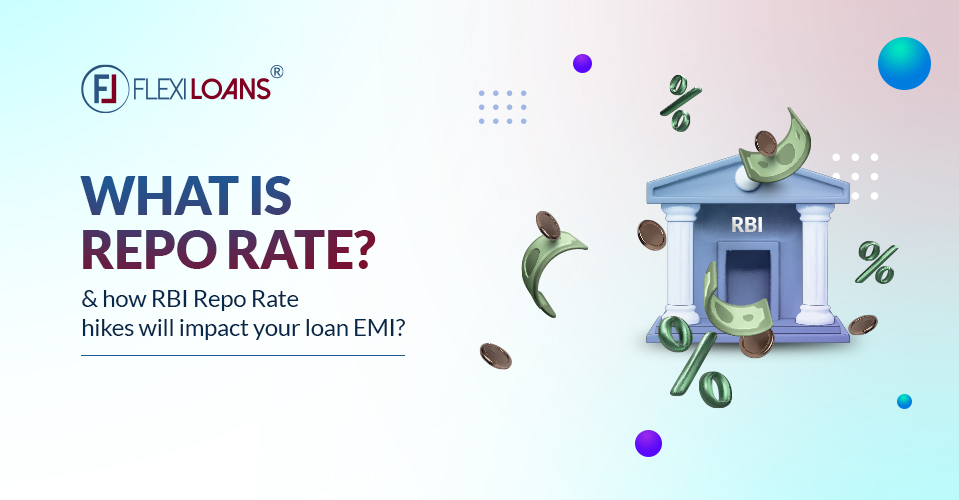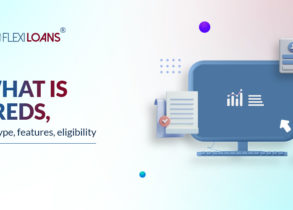Jul 02, 2022
Jun 20, 2025

If we need a loan, the first step is to approach a bank or a non-banking financial institution. The bank decides the rate of interest on loans based on our credit score, loan amount, and duration of the business loan.
In a significant move that continues to shape India’s financial landscape, the Reserve Bank of India (RBI) has kept the repo rate unchanged at 6.5% for the ninth consecutive time. This decision impacts various facets of the economy, particularly loans for businesses. Understanding what the repo rate is, why it’s important, and how it affects your business loans is crucial for making informed financial decisions.
What is the Repo Rate?
A form of short-term borrowing, the full form of repo rate is a repurchase agreement or option. In order to secure the loan, banks need to provide securities like government bonds or treasury bills as securities.
The repo rate represents the rate at which the RBI lends money to commercial banks in India when funds run short. When it rises, borrowing costs increase, typically reducing spending and helping control inflation. Conversely, a lower repo encourages borrowing and investment, thereby stimulating economic growth.
Understanding this becomes crucial, especially if you’re planning to apply for a business loan or are already managing one. It directly impacts the interest you’ll pay, influencing your monthly installments (EMIs).
Why is the Repo Rate Important?
It plays a vital role in influencing all lending rates across the banking system. Here’s why it matters:
- Interest Rates: A change in the repo rate leads to a corresponding change in the interest rates for loans and deposits. For instance, if it increases, banks may raise the interest rates on loans, making borrowing more expensive.
- Economic Growth: The repo rate affects the flow of money in the economy. A lower rate means cheaper loans, encouraging businesses to borrow, invest, and expand, thus driving economic growth.
- Inflation Control: Adjusting the repo rate enables the RBI to control inflation. When inflation rises, the RBI may increase it to reduce spending and cool down the economy.
Understanding this can help you make better financial decisions, whether you’re considering a business loan or managing existing debts.
What Is Reverse Repo Rate?
The Reverse Repo Rate is the interest rate at which commercial banks lend money to the Reserve Bank of India (RBI). It functions in contrast to the repo rate, where the RBI lends money to the banks.
The Relation Between the Repo Rate and Loan EMIs
There is a direct correlation between repo rate and EMIs. The higher the repo rate, the higher the EMI and the lower the repo rate, the lower the EMI. For quicker results, we can use an online EMI calculator for a business loan to calculate the EMI by entering details like the amount of the loan, the interest rate, and the repayment period.
Repo vs Reverse Repo Rate
The repo rate and reverse repo rate are key tools used by the Reserve Bank of India (RBI) to regulate liquidity and control inflation.
Definition and Purpose
- Repo Rate: This is the rate at which the RBI lends money to commercial banks when they face a shortfall of funds. It’s primarily used to inject liquidity into the banking system.
- Reverse Repo Rate: This is the rate at which the RBI borrows money from commercial banks, mainly to absorb excess liquidity from the economy.
Impact on Liquidity
- Repo Rate: An increase in the repo rate makes borrowing more expensive for banks, reducing liquidity. A decrease makes borrowing cheaper, increasing liquidity.
- Reverse Repo Rate: An increase encourages banks to park funds with the RBI, reducing liquidity. A decrease discourages this, increasing liquidity.
Effect on Interest Rates
- Repo Rate: Directly influences loan and deposit interest rates; higher repo rates usually lead to higher loan rates.
- Reverse Repo Rate: Indirectly impacts interest rates by influencing banks’ lending behavior.
Monetary Policy Use
- Repo Rate: A primary tool for combating inflation or stimulating growth, signaling broader monetary policy shifts.
- Reverse Repo Rate: A complementary tool for managing short-term liquidity.
Impact of Repo Rate Hike on Various Aspects
When the repo rate increases, it triggers a ripple effect across different sectors of the economy. Here’s how the hike impacts various aspects:
1. Loan EMIs
A repo rate hike raises borrowing costs. With a floating interest rate, your EMIs will increase, straining cash flow. Use a business loan EMI calculator to assess the new burden.
2. Consumer Spending
Higher borrowing costs reduce consumer spending. As loans become more expensive, individuals and businesses may delay or cut back on purchases and investments, slowing economic activity, especially in sectors like real estate, automobiles, and consumer goods.
3. Business Investment
Businesses rely on loans for expansion, machinery, or working capital. A repo rate hike raises loan costs, potentially slowing investment. Companies may delay expansion or seek alternatives like business loans without collateral or a line of credit.
4. Inflation Control
A key reason for a repo rate hike is to control inflation. Higher interest rates reduce the money supply, cooling demand and stabilising prices. While effective for inflation control, it may also slow economic growth.
5. Savings and Investments
A higher repo rate often leads to increased interest on deposits and savings accounts. This benefits savers, as they earn more on their deposits. However, for businesses, the higher cost of borrowing may outweigh the benefits of higher returns on savings.
6. Currency Value
A repo rate increase can strengthen the domestic currency by attracting foreign investors seeking higher returns. However, a stronger currency may make exports more expensive, potentially reducing the competitiveness of businesses in global markets.
7. Impact on MSMEs
MSMEs are especially sensitive to interest rate changes. A repo rate hike increases their financial burden, as they often operate with limited cash flow and rely heavily on MSME loans. This highlights the need to negotiate favourable loan terms or explore MSME loans without collateral.
The Relation Between the Repo Rate and Loan EMIs
The repo rate directly impacts your loan EMIs. Here’s how:
- Floating Interest : If you’ve opted for a floating interest rate on your business loan, any change in the repo rate will directly affect your EMIs. For example, a hike in the repo rate may lead to an increase in your EMIs, making your loan more expensive.
- Fixed Interest : With a fixed interest rate, your EMIs remain unchanged throughout the loan tenure, regardless of fluctuations in the repo rate. However, new loans will likely have higher interest rates if the repo rate increases.
- EMI Calculators: Using a business loan EMI calculator or a term loan EMI calculator helps you estimate the impact of any changes in the repo rate on your EMIs.
Tracking the repo rate is essential for managing your finances effectively. It can also guide you in choosing the right loan products, such as unsecured business loans or machinery loans, based on the current economic scenario.
How Can We Calculate EMI for Business Loans?
We can easily determine the monthly EMI outgo with free online tools like a business loan EMI calculator. Thanks to the Government of India’s initiatives to introduce concessional interest rates on business loans, women who want to start a business can now enjoy some added benefits.
There are two components of an EMI for business loans:
- Principal Repayment
- Interest (depends on the current interest rate)
Let us understand how EMIs work with an example.
Amount of business loan: Rs. 20,00,000
Interest rate: 12% per annum
Loan tenure: 20 years
When we enter this data in the online business loan EMI calculator, our monthly installment would be Rs. 22,022. The total interest payable over the 20-year period stands at Rs. 32,85,213. The total outstanding, including principal and interest, is Rs. 52,85,213 (Rs. 20,00,000 being the principal loan and Rs. 32,85,213 the interest on the loan).
Now let us assume that the repo rate has gone up, leading to the interest on MSME loans going up by 2% to 14% per annum.
Amount of business loan: Rs. 20,00,000
Interest rate: 14% per annum
Loan tenure: 20 years
When we enter the revised interest rate in the business loan calculator, we find that our EMI has gone up to Rs. 24,870 per month. Our total interest outgo for the same period has also increased to Rs. 39,68,900. We would also have a total payout commitment of Rs. 59,68,900.
Per the above calculation, with a 2% increase in annual interest rates, our monthly EMI liability goes up by Rs. 2,848, and total interest and total loan amount also go up by Rs. 6,83,687.
Eligibility criteria for business loans application process
MSME loans
Who is eligible for MSME loans?
- Individuals between 21 and 65 years of age
- At least 5 years of experience
- Business operational for at least a year with a minimum monthly turnover of Rs. 2,00,000
How to apply for MSME loans?
- Submit an online application after ensuring every detail entered is correct.
- Upload all the required documents.
- The Credit score is analyzed.
- The loan amount gets disbursed
There are lenders who provide MSME loans without collateral. This means, we don’t need to provide any asset as security or collateral to the lender.

How Can EMIs on MSME Loans be Reduced?
Reducing your EMIs can significantly ease the financial burden on your business. Here’s how you can do it:
- Opt for a Longer Tenure: Extending the loan tenure can lower your monthly EMI, making it more manageable.
- Prepay When Possible: If you have extra funds, consider making prepayments. This reduces the principal amount, thereby lowering future EMIs.
- Negotiate the Interest Rate: Don’t hesitate to negotiate with lenders for a lower interest rate, especially if you have a good credit score.
- Refinance Your Loan: If you discover a lender with a lower interest rate, refinancing your current loan could lead to considerable savings on your EMIs.
FlexiLoans offers flexible repayment options and competitive interest rates, making it easier for you to manage and reduce your EMIs.
Final Thoughts
Repo rate hikes lead to a higher rate of interest on term loans, but with easy financing through online lending platforms like FlexiLoans.
Understanding the RBI’s decision to keep the repo rate unchanged at 6.5% is crucial for managing your business finances, especially if you’re considering a business loan. This knowledge helps you make informed decisions about your loan’s interest rates, EMIs, and overall financial planning.
FlexiLoans makes it easy for businesses across India, to get loans sanctioned quickly and efficiently. Whether you’re looking for a working capital loan, a collateral-free business loan, or a line of credit, FlexiLoans provides customized solutions tailored to your business needs. With the right financial partner, growing your business becomes simpler and more accessible.







